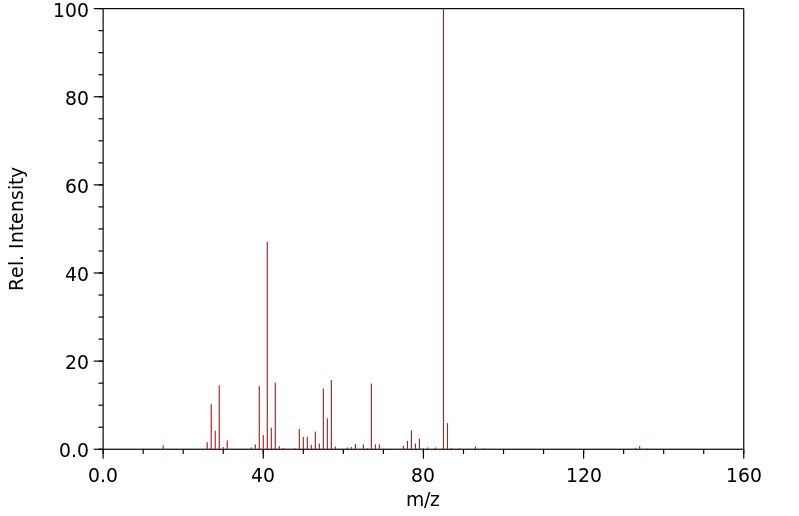2-(chloromethyl)tetrahydropyran | 130233-14-6
中文名称
——
中文别名
——
英文名称
2-(chloromethyl)tetrahydropyran
英文别名
2-(chloromethyl)-tetrahydro-2H-pyran;2-(Chloromethyl)tetrahydro-2H-pyran;2-(chloromethyl)oxane
CAS
130233-14-6
化学式
C6H11ClO
mdl
MFCD00006622
分子量
134.606
InChiKey
PPYKTTGONDVGPX-UHFFFAOYSA-N
BEILSTEIN
——
EINECS
——
-
物化性质
-
计算性质
-
ADMET
-
安全信息
-
SDS
-
制备方法与用途
-
上下游信息
-
文献信息
-
表征谱图
-
同类化合物
-
相关功能分类
-
相关结构分类
物化性质
-
沸点:166.4±0.0 °C(Predicted)
-
密度:1.035±0.06 g/cm3(Predicted)
计算性质
-
辛醇/水分配系数(LogP):1.6
-
重原子数:8
-
可旋转键数:1
-
环数:1.0
-
sp3杂化的碳原子比例:1.0
-
拓扑面积:9.2
-
氢给体数:0
-
氢受体数:1
反应信息
-
作为反应物:参考文献:名称:Single electron transfer mechanism in the reaction of 1,3-dithianyllithium and alkyl iodides摘要:The reaction between 2-lithio-1,3-dithiane and optically active (R)-2-iodooctane was found to proceed with complete inversion of configuration. This result suggests that the S(N)2 (rather than single electron transfer (SET) mechanism is the preferred pathway for reaction between dithianyllithium and unhindered alkyl halides. When the neopentyl-type radical probe 5,5-dimethyl-6-iodo-1-hexene was used as the substrate halide, 6-11% cyclized alkylated product was obtained. This result suggests that when the S(N)2 pathway is blocked, SET mechanisms become operative to some extent, at least with iodide as the halogen. The reaction of dithianyllithium and (R)-2-iodooctane and 5,5-dimethyl-6-iodo-1-hexene, with hexane as the solvent, proceeds under heterogeneous conditions to bring about complete racemization or cyclization of the respective iodide. These results demonstrate for the first time that 2-lithio-1,3-dithiane can act as electron donor in reactions initiated by electron transfer to alkyl iodides.DOI:10.1021/jo00004a051
-
作为产物:参考文献:名称:[6,6]-螺缩醛烯醇醚的丙烯酸化:反应性和重排摘要:试图在2位上选择性芳基化[6,6]-螺缩醛烯醇醚提供了意想不到的结果。钯介导的芳基化条件提供了Double-Heck产物,而与苯亚磺酸的反应导致轻而易举的重排成相应的5-苯基磺酰基-3,4,5,6-四氢苯并二氢吡喃,提供了对5-芳基-3,4, 5,6-四氢苯并吡喃和六氢苯并吡喃衍生物。DOI:10.1016/j.tetlet.2010.12.076
文献信息
-
Pheromonsynthesen ‐ Modellreaktionen zur Synthese von Polyether‐Antibiotika作者:Robert E. Ireland、Dieter HäbichDOI:10.1002/cber.19811140419日期:1981.4Schema zur Synthese von Spiroketalen wird vorgestellt. Die Hetero-Diels-Alder-Reaktion zwischen einem exocyclischen Enolether 5 und einer α,β-ungesättigten Carbonylverbindung führt zu Spiroalkenen 6. Diese lassen sich durch oxidative Ringkontraktion oder Reduktion zu 7 oder 8, den gemeinsamen Strukturelementen verschiedener Polyether-Antibiotika und Insekteninhaltsstoffe, umsetzen. Modellreaktionen zuEin allgemeines,konvergentes Schema zur Synthese von Spiroketalen wird vorgestellt。Die Hetero-Diels-Alder-Reaktion zwischen einem exocyclischen Enolether 5和einerα ,β-ungesättigtenCarbonylverbindungführtzu Spiroalkenen 6。Diese lassen sich durch氧化Ringkontraktion oder Reduktion zu 7 oder 8,geminsinsamen Strukturelementen verschiedener聚醚-Antibiotika和Insekteninhaltsstoffe,umsetzen。型号为Sequenz的双模,2-甲基四氢吡
-
Total Synthesis of the Epidermal Growth Factor Inhibitor (−)-Reveromycin B作者:Anthony N. Cuzzupe、Craig A. Hutton、Michael J. Lilly、Robert K. Mann、Kenneth J. McRae、Steven C. Zammit、Mark A. RizzacasaDOI:10.1021/jo001646c日期:2001.4.1The total synthesis of the epidermal growth factor inhibitor reveromycin B (2) in 25 linear steps from chiral methylene pyran 13 is described. The key steps involved an inverse electron demand hetero-Diels-Alder reaction between dienophile 13 and diene 12 to construct the 6,6-spiroketal 11 which upon oxidation with dimethyldioxirane and acid catalyzed rearrangement gave the 5,6-spiroketal aldehyde描述了由手性亚甲基吡喃13在25个线性步骤中表皮生长因子抑制剂reveromycin B(2)的总合成。关键步骤涉及亲二烯体13和二烯12之间的逆电子需求异Diels-Alder反应,以构建6,6-螺酮11,在被二甲基二环氧乙烷氧化和酸催化的重排后,得到5,6-螺酮醛9。乙炔化锂加入后再进行氧化/还原和保护基操作,提供了白霉素B螺环酮核心8,将其转化为白霉素A(1)衍生物6以确认螺环酮区段的立体化学。C1-C10侧链的引入始于连续的Wittig反应,以形成C8-C9和C7-C6键,锡介导的不对称羟醛反应安装了C4和C5立体中心。靶分子2的最终关键步骤涉及Stille偶联以引入C21-C22键,琥珀酰化,选择性脱保护,氧化和Wittig缩合以形成最终的C2-C3键。通过在DMF中的TBAF进行脱保护,以72%的收率得到Reveromycin B(2)。
-
A New Simple and Industrial Process for Bromination of Alcohols作者:Jean-Manuel Mas、Pascal MetivierDOI:10.1080/00397919208019071日期:1992.8Abstract Alcohols treated with thionyl chloride, followed by chlorine/bromine exchange using gaseous hydrobromic acid and thermal decomposition in the presence of a tertiary amine give the corresponding brominated compounds. The process is regio/stereo selective.
-
Nickel-Catalyzed Cross-Electrophile Coupling of Aryl Chlorides with Primary Alkyl Chlorides作者:Seoyoung Kim、Matthew J. Goldfogel、Michael M. Gilbert、Daniel J. WeixDOI:10.1021/jacs.0c02673日期:2020.6.3Alkyl chlorides and aryl chlorides are among the most abundant and stable carbon electrophiles. Although their coupling with carbon nucleophiles is well developed, the cross-electrophile coupling of aryl chlorides with alkyl chlorides has remained a challenge. We report here the first general approach to this transformation. The key to produc-tive, selective cross-coupling is the use of a small amount
-
Self-Assembly and Solid-State Polymerization of Butadiyne Derivatives with Amide and Trialkoxyphenyl Groups作者:Kohei Kikuchi、Yoko Tatewaki、Shuji OkadaDOI:10.1246/bcsj.20160347日期:2017.3.15electron microscope (SEM) observations. We found that all compounds had at least two polymorphs. Property differences between two polymorphs depended on the compounds. Two compounds showed clear differences in UV–vis spectra of the photopolymerized solids, i.e., the polydiacetylene (PDA) structure, and irregularly polymerized form, or two PDA structures. The remaining compound showed the same PDA absorption合成了三种具有酰胺和三(十二烷氧基)苯基(TDP)基团的丁二炔衍生物,并应用四种固化方法获得了它们在各种条件下的自组装状态。获得的固体通过固态聚合行为、酰胺基团的 N-H 键的伸缩振动波数、粉末 X 射线衍射、热行为和扫描电子显微镜 (SEM) 观察进行表征。我们发现所有化合物都至少有两种多晶型物。两种多晶型物之间的特性差异取决于化合物。两种化合物在光聚合固体的紫外-可见光谱中表现出明显的差异,即聚二乙炔 (PDA) 结构和不规则聚合形式,或两种 PDA 结构。其余化合物显示相同的 PDA 吸收,但单体熔点不同。由于具有酰胺和 TDP 基团的分子设计,所有化合物都在各种有机溶剂中形成凝胶。SEM观察阐明了相关...
表征谱图
-
氢谱1HNMR
-
质谱MS
-
碳谱13CNMR
-
红外IR
-
拉曼Raman
-
峰位数据
-
峰位匹配
-
表征信息
同类化合物
(3S,4R)-3-氟四氢-2H-吡喃-4-胺
鲁比前列素中间体
顺式-3-溴<2-(2)H>四氢吡喃
顺-4-氨基四氢吡喃-3-醇
顺-4-(四氢吡喃-2-氧)-2-丁烯-1-醇
顺-3-Boc-氨基-四氢吡喃-4-羧酸
锡烷,三丁基[3-[(四氢-2H-吡喃-2-基)氧代]-1-炔丙基]-
螺[金刚烷-2,2'-四氢吡喃]-4'-醇
蒿甲醚四氢呋喃乙酸酯
蒜味伞醇B
蒜味伞醇A
茉莉吡喃
苯基2,4-二氯-5-氨磺酰苯磺酸酯
苄基2,3-二-O-乙酰基-4-脱氧-4-C-硝基亚甲基-β-D-阿拉伯吡喃果糖苷
膜质菊内酯
红没药醇氧化物A
红没药醇氧化物
科立内酯
硅烷,(1,1-二甲基乙基)二甲基[[4-[(四氢-2H-吡喃-2-基)氧代]-5-壬炔基]氧代]-
甲磺酸酯-四聚乙二醇-四氢吡喃醚
甲基[(噁烷-3-基)甲基]胺
甲基6-氧杂双环[3.1.0]己烷-2-羧酸酯
甲基4-脱氧吡喃己糖苷
甲基3-脱氧-3-硝基-beta-L-核吡喃糖苷
甲基2,4,6-三脱氧-2,4-二-C-甲基吡喃葡己糖苷
甲基1,2-环戊烯环氧物
甲基-[2-吡咯烷-1-基-1-(四氢-吡喃-4-基)-乙基]-胺
甲基-(四氢吡喃-4-甲基)胺
甲基-(四氢吡喃-2-甲基)胺盐酸盐
甲基-(四氢吡喃-2-甲基)胺
甲基-(四氢-吡喃-3-基-胺
甲基-(四氢-吡喃-3-基)-胺盐酸盐
甲基-(4-吡咯烷-1-甲基四氢吡喃-4-基)-胺
甲基(5R)-3,4-二脱氧-4-氟-5-甲基-alpha-D-赤式-吡喃戊糖苷
环氧乙烷-2-醇乙酸酯
环己酮,6-[(丁基硫代)亚甲基]-2,2-二甲基-3-[(四氢-2H-吡喃-2-基)氧代]-,(3S)-
环丙基-(四氢-吡喃-4-基)-胺
玫瑰醚
独一味素B
溴-六聚乙二醇-四氢吡喃醚
氯菊素
氯丹环氧化物
氨甲酸,[[(四氢-2H-吡喃-2-基)氧代]甲基]-,乙基酯
氨甲酸,[(4-氨基四氢-2H-吡喃-4-基)甲基]-,1,1-二甲基乙基酯(9CI)
氧杂-3-碳酰肼
氧化氯丹
正-(四氢-4-苯基-2h-吡喃-4-基)乙酰胺
次甲霉素 A
桉叶油醇
无







